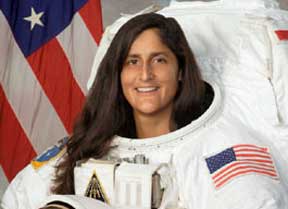TNN :AHMEDABAD: The space travel by
Sunita
Williams has generated a lot of interest among Indians, particularly
among Gujaratis. But only a few know that the second woman astronaut of
Indian origin, after
Kalpana
Chawla, also shoulders responsibility of expanding horizons of science
as we know it.
Talking about the expedition, the scientists in the state
said that the three astronauts from the US, Russia and Japan - identified as
Expedition 33 crew - will be joining three Russian astronauts in orbit since
May. The group will work together for two months after which the latter are
scheduled to be back in September. The group led by Williams is scheduled to
come back in mid-November.
The new crew members are expected to conduct over 30 scientific missions
with about 240 experiments during their stay aboard the ISS.
What the expedition means for science
Space exploration: Robotic arm developed by Japan will
be launched for technology development and demonstration for air, water, and
surface monitoring. Aquatic habitat will be established for fish in zero
gravity to learn more about bone and muscle atrophy (medical issues for the
aging population) and radiation impact. Communication delay study will be
carried out with new equipments to assist scientists understand relay and
response time of a signal from mars and other objects in solar system.
Spectrometer aboard ISS collects 1.2 billion particles per month and
collects valuable data about space.
Humans in space: NASA's light microscope will provide better
understanding of crystallization and ageing in food and other products. It
will help scientists prepare food with much longer shelf life for space
exploration. The astronauts will further research on effects of
long-duration spaceflight on human body including disturbance in sleep
pattern and circadian rhythm.
Healthcare: Miniaturized flow cytometer, Microflow1, developed by
Canada, uses
laser to analyze individual cells for cell counting and sorting, biomarker
(disease signatures) detecting, and protein engineering. The equipment will
be tested for early disease identification. Vaccine for
salmonella
will be tested for prevention of infection on earth and in microgravity.
Salmonella is the most common cause for food poisoning and death in
children.
Nanotechnology: NanoRacks, micro plates containing nano particles of
plant and animal tissues, will be carried to the ISS to study impact of zero
gravity situations on them. It will expand our understanding of life science
and probable life forms in the space.
Earth science: ISS SERVIR Environmental Research and Visualization System
(ISERV) will lead to the development of enhanced capabilities that will
provide useful images to support disaster and other events' monitoring and
assessment, and environmental decision making when needed.
Chemistry: Facility for Absorption and Surface Tension (FASTER) will be
flown for the first time on the space station. It will conduct research on
physical chemistry properties and emulsion stability of droplet interfaces.
Its outcome can help industries make emulsion of two generally separate
liquids such as water and oil.



